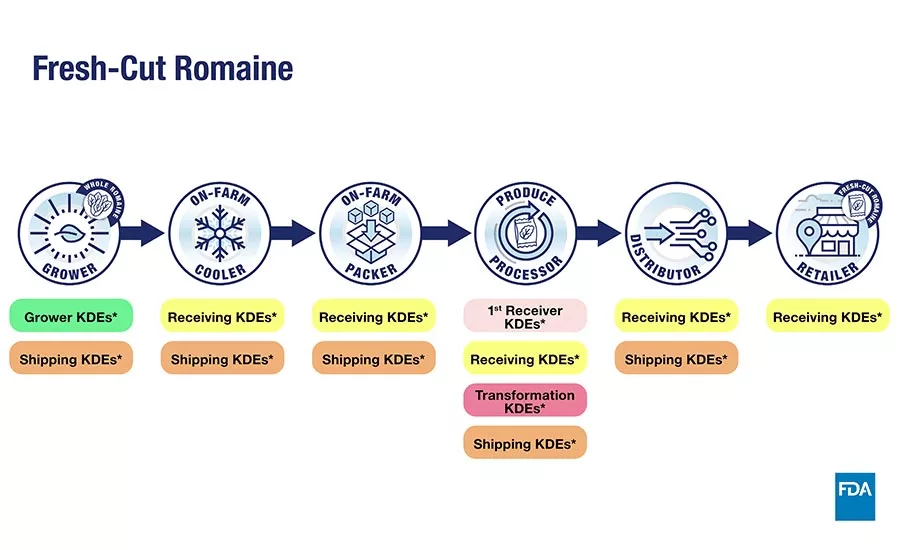Manufacturing News
FDA proposes new FSMA rule for food traceability
In a major move, FDA is adding new rules to make it easier to electronically track contaminated food anywhere in the supply chain

Under the FSMA Proposed Rule for Food Traceability, fresh-cut romaine lettuce would require recording of key data elements (KDEs) beginning at the farm and continuing through the supply chain to the retailer. If a problem occurs anywhere, supply chain participants must provide electronically “sortable” spreadsheets within 24 hours of an FDA request.
Source: FDA
Spawned by a seemingly unending parade of produce recalls over the last few years, FDA’s new FSMA Proposed Rule for Food Traceability strives to demand electronic traceability of food from farm-to-retail for several food types prone to bacterial contamination.
“When we say traceability, what we are really talking about is the ability to track a food at every step of the supply chain,” says Frank Yiannas, deputy commissioner for Food Policy and Response, FDA.
“While limited to certain foods, this proposed rule would create a first-of-its-kind, standardized approach to traceability recordkeeping, paving the way for industry to adopt and leverage more digital, tech-enabled traceability systems both in the near term and the future,” adds Yiannas. “We are also releasing a draft food traceability list (FTL) that identifies foods to which the additional recordkeeping requirements would apply.”
This FTL includes, in brief, the following: cheeses (other than hard), shell eggs, nut butters, cucumbers, fresh herbs, leafy greens, melons, peppers, sprouts, tomatoes, tropical tree fruits, fresh-cut fruits and vegetables, finfish, crustaceans, mollusks, bivalves, and RTE deli salads.
The proposed rule requires companies that manufacture, process, pack or hold foods on the list to establish and maintain records containing key data elements associated with different critical tracking events (CTEs). While the proposed regulations would only apply to foods on the FTL, they were designed to be suitable for all FDA-regulated food products. FDA is encouraging the voluntary adoption of these practices industrywide.
“When we look at the current state of traceability across the food supply, we find that even though some food producers, manufacturers and retailers have adopted modern, effective traceability systems, rarely are these systems compatible with each other,” says Yiannas. “And still, many other food companies have not adopted traceability systems at all. Simply put, we lack a harmonized system of traceability from farm to fork that is universally understood and utilized.”
FDA’s ability to track and trace specific products through the supply chain is often hampered by a lack of data. FDA conducted extensive research in developing an approach that would standardize the data elements and information processors must establish and maintain—along with information they must send to the next entity in the supply chain. FDA is hoping that this technology can narrow down and pinpoint specific products—e.g., a specific batch of romaine lettuce causing an outbreak that needs to be quarantined—rather than having to shut down all romaine lettuce shipments.
Depending on the supply chain, different monitoring actions will be required. For example, most farm direct-to-consumer transactions are exempt. Key data elements to be recorded occur during the receiving, creating (making or producing a food on the FTL using ingredients not on the FTL), and transforming (changing and/or packaging food on the FTL) of food. CTEs include all pertinent shipping data, including shippers, lot codes, bills of lading, times, etc.
Other examples of exemptions include certain fishing vessels, transporters of FTL foods, farm-to-school, and processors that apply a kill step to FTL foods.
The proposed rule is open for public comment until Jan. 21, 2021. For instructions, search the internet for “Requirements for Additional Traceability Records for Certain Foods” in the Federal Register. For more details the rule, FDA has provided a scope, definitions of terms, key features, working examples, implementation and additional information on its FSMA website.
Looking for a reprint of this article?
From high-res PDFs to custom plaques, order your copy today!







